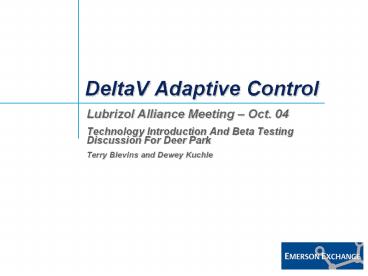DeltaV Adaptive Control - PowerPoint PPT Presentation
1 / 23
Title:
DeltaV Adaptive Control
Description:
DeltaV Adaptive Control Lubrizol Alliance Meeting Oct. 04 Technology Introduction And Beta Testing Discussion For Deer Park Terry Blevins and Dewey Kuchle – PowerPoint PPT presentation
Number of Views:150
Avg rating:3.0/5.0
Title: DeltaV Adaptive Control
1
DeltaV Adaptive Control
- Lubrizol Alliance Meeting Oct. 04
- Technology Introduction And Beta Testing
Discussion For Deer Park - Terry Blevins and Dewey Kuchle
2
Agenda
- Introduction To Adaptive Control
- Quick Demonstration
- Beta Testing
- What Does This Mean For Lubrizol And Emerson
3
Control Loop Performance - A Never Ending Cycle
Evaluate Poor Performance
Process Testing (bump tests)
The more often you Tune, the better the
performance. Period.
Control Degrades Over Time
Calculate Tuning
Operate The Loop
Deploy New Controller
4
There Must Be A Better Way
Wouldnt it be nice to have controllers use
optimal tuning all the time (continually) without
having to tune at all, ever?
5
Basics Gain, Dead Time, Time Constant
6
Adaptive Control Continuous Adjustment
Continuous automatic adjustment of tuning
parameters means better control. Easy.
Starting Point
Controller Gain
More Aggressive
Less Aggressive
But dont forget about the time constant and the
dead time.
7
DeltaV Adapt
No Tuning Required!
- Fully Adaptive PID Control Tuning
- Learns Process Dynamics While In Automatic
Control - No Bump Testing Required
- Works On Feedback And Feedforward
- Patents Are Now Awarded!
8
DeltaV Adapt Field Trials At Eastman
As Operators Make Set Point Changes Adapt Gets
Smarter!
9
Set Point Change
Set Point Change
Better Tuning Dramatically Increases Performance
Slow Response Causes Off- Spec
10
Not an overnight thing
- EMERSON technology developed in Austin.
- Patents have now been awarded.
- 1997 - Dr. Wojsznis concept originated
- 1998 - Started research at Hawk Austin
- 2002 - Started product development
- 2003 - Prototypes at Texas Eastman in Longview
Texas with good results. Results presented at
ISA2003. - 2004 Pre-beta test at Solutia in Pensacola,
Florida. Results are scheduled for publication
in Sept issue of Chemical Process magazine
front cover, feature article. - 2005 - Initial release planned for DeltaV v8.1
11
Patents Have Now Been Awarded!
Dr. Wilhelm Woszjnis
Mr. Terry Blevins
12
Operating Condition Impact
- Process gain and dynamics may change as a
function of operating condition as indicated by
PV, OUT or other measured parameters e.g. plant
throughput
13
Defining Operating Regions
- Adaptive control allows operating regions to be
defined as a function of an input state
parameter - Define up to 5 regions
- When the state parameter changes from one region
to another, the model values (and associated
tuning) immediately change to the last model
determined for the new region - Limits on model parameter adjustment are defined
independently for each region.
Region 1
Region 2
Region 1
Region 2
Region 3
Region 4
Region 5
14
Example Non-Linear Installed Characteristics
- Process gain will change as a function of valve
position if the final control element has
non-linear installed characteristics. - Valve position is used as the state parameter.
15
Example Multiple Valves - Split Range
- The process gain and dynamic response to a change
valve position may be different for each valve. - Typical example is heating/cooling of batch
reactor, extruder, slaker, etc. - Valve position is used as the state parameter.
16
DeltaV Adaptive Control Field Trials
- Control automatically adapts based on SP changes
in Auto Caustic loop
17
The End Result
- This capability will allow DeltaV users to assign
ballpark tuning parameters and let adaptive PID
controllers tighten them up and adapt over time. - Patented model switching technology means robust
control over the long haul without sacrificing
performance - Faster startups, quicker ramp-up of production,
less tuning over time, and better control over
the life of the system all mean better economics.
18
But What About Previous Attempts?
- Most Every Other Attempt To Build Adaptive
Controllers Have Been Based On One Of Two
Approaches - Heuristics or Rules Based Adaptation
- Pattern Recognition
Both Methods Have Met With Limited Success
19
So What Makes This Different?
- Truly Model Based Tuning
- Built On Advanced Closed Loop Modeling
- Tuning Based On Science And Fact With No Shortcuts
20
What Does That Mean?
- In The 90s The MIT Blackjack Team Invaded Las
Vegas And Broke The House, Taking Casinos For
Millions - They Did It Counting Cards Which Is Really A Form
Of Modeling
21
Delivering Results
From This
To This
22
Delivering Results
With NO Hands!
23
DeltaV Adapt
- Demonstration































